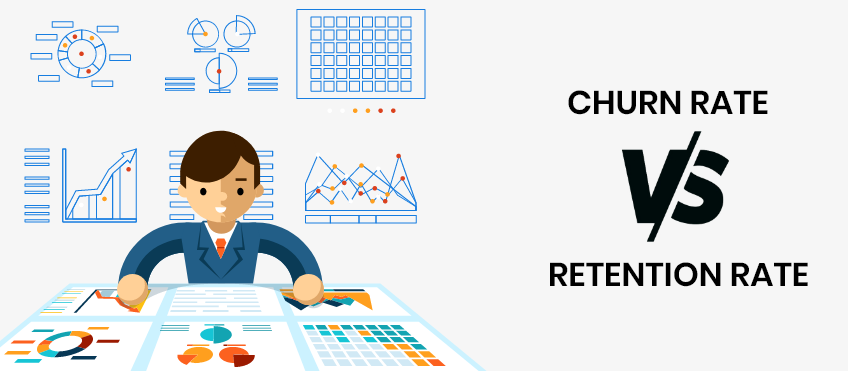Churn rate vs Retention rate – Complete guide for 2024 – Updated

Churn rate vs Retention rate – Complete guide for 2024 – Updated
In the B2B space, customer retention is very important. However, many companies don’t focus on building a customer retention strategy and in most cases, the customer success team doesn’t get rewarded in the same way a salesperson would get compensated for closing a new customer. Customer retention doesn’t have the same broad appeal as other closed deals. Somehow, it doesn’t make sense. And on the other side, it’s important for the growth of any business as the cost of accumulating a new user is much greater than maintaining and growing an existing account. It has been seen that growing companies prioritize customer success more than stagnating ones and that retention increases by 5% giving the profits anywhere from 25% to 95%.
What is customer retention management?
Customer retention management refers to the steps that are taken to discover and record them well on how a business is retaining the customers and their revenue. The process is done by looking at key customer retention metrics like churn rate and customer lifetime value.
The companies track their success in this area to see how well they are fulfilling their customer needs and if they are continuing to earn their business over time.
Some of the customer retention metrics are:
- Customer Churn
- Revenue Churn
- Existing Customer Growth Rate
- Repeat Purchase Ratio
- Product Return Rate
- Days Sales Outstanding
- Net Promoter Score
- Time Between Purchases
- Loyal Customer Rate
- Customer Lifetime Value
What is customer churn?
Customer churn is one of the most straightforward customer retention metrics. The customer churn rate refers to the rate at which the customers stop doing business with you. The customer churn can be because your customer has ended the subscription or opted out of renewing a subscription.
A churned customer is a customer that your company unsuccessfully retained. The churn rate at a certain level is natural in your customer base. The reason could be anything when they no longer need your service like they are acquired or go out of business, they have hired an internal resource, or no longer needs your product/service, etc.,
In case, your churn rate is more than 5-7%, then you should evaluate your customer retention strategy and find out why there may be a problem. The high churn rate shows that your service or product is failing to satisfy your client’s needs or wants.
Sometimes, churn rate is referred to as retention rate but both are entirely different metrics.
How to calculate customer churn?
The volume of business your company conducts tells how often you should calculate and examine your company’s churn rate. Like, if you have hundreds or thousands of customers, it may be safe for your sales, marketing, or customer success team to track churn daily. If you have a small user base or customer signed onto longer contracts, a semi-annual or annual checking will work well. You should keep in mind that new customers you boarded in whatever period should not be factored into the churn rate.
Annual Churn Rate = (Number of Customers at Start of Year – Number of Customers at End of Year) / Number of Customers at Start of Year
Example of Customer Churn
We can use the following example metrics to calculate the churn rate.
Churn Rate
Let’s say our company started December with 10K customers. At the end of the month, we found that 500 left our business. This would mean our churn rate is five percent ((10,000 customers – 9,500 customers ) / 10,000 customers = 5%).
Now, let’s say we gained 275 customers during August and lost 500 more during March. Our churn rate for March would then be 5.11% ((9,775 customers – 9,225 customers) / 9,755 customers = 5.11%).
What is the revenue churn rate?
The revenue churn rate is the percentage of revenue you’ve lost from existing customers in a given period. The revenue churn can result from an order cancellation, a plan downgrade, or an end to a business relationship. Particularly for SaaS (Software as a Service) companies, the revenue churn rate indicates the customer’s health and satisfaction. The broad revenue churn rate provides an overall view of customer’s health, it must be tracked on an individual basis. The main objective of your customer’s support team is to proactively ensure customers aren’t having any problems while using your product or service, before even approaching the point where they downgrade their subscription.
Whenever revenue churn happens, it simply means that your customer is on the verge of leaving, and at that time your management team should quickly take action to prevent this from happening.
How to calculate revenue churn?
The revenue churn rate should be calculated every month. To calculate the revenue churn rate start with subtracting the monthly recurring revenue (MRR) at the end of the month from the MRR you had at the beginning of the month.
Subtract any revenue you accrued from up-selling or cross-selling to existing customers. Lastly, divide the number by the MRR you had at the beginning of the month. The answer you will get will be a negative percentage, which will mean your revenue gains from existing customer gains surpassed any losses. You should keep in mind that revenue from new customers should not be included in this calculation.
Monthly Revenue Churn Rate = [(MRR at Start of Month – MRR at End of Month) – MRR in Upgrades during Month] / MRR at Start of Month
Example of Revenue Churn Rate
Let’s use a related example to the one we used above to calculate the revenue churn rate
Let’s assume that our company began in October with an MRR of $50K. In that month, we lost $5K to churn and gained $2.5K from upgrades. For this month, our revenue churn rate would be five percent. ([($50,000 – $45,000) – $2,500] / $50,000 = 5%).
For November, since we’ve gained $2.5K in upgrades as well as $10K in new MRR our starting MRR is going to be $57,500. If we lose $7K to churn and gain $3K to upgrades, our churn rate would be 6.95% ([($57,500 – $50,500) – $3,000] / $57,500 = 6.95%).
Churn rate vs retention rate
Retention rate is the ratio of customers that return to do business at your company. The retention rate is different from the churn rate as the churn rate implies the number of customers you have lost over some time. A company with a high churn rate will have a lower retention rate.
Retention rate is the number of customers you’ve retained over a specific period. User churn rate is also referred to as Attrition Rate and is defined as the percentage of customers who have canceled or unsubscribed from your service during a specific period.
And if your retention rate for a certain period is 90%, your churn rate for that same period is 10%.










